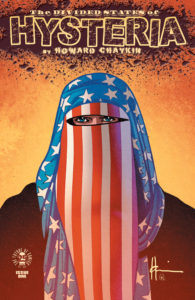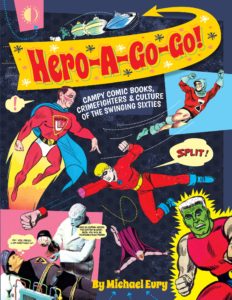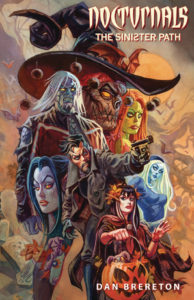Apologies for the delay in getting this posted; I mean to do these every month but sometimes life kinda interferes with writing time. Anyways, welcome back to Confessions of a CSJ, in which I take forever and a day to opine on stuff I’ve read recently, which may or may not be available at a comics shop or online retailer at your convenience.
 The Divided States of Hysteria #1, 2
The Divided States of Hysteria #1, 2
Image Comics, Writer/Artist: Howard Chaykin
Digital : $1.99; Print: $3.99
I guess I could begin this review this way, in Chaykin style: “…after what seems like a decade of fucking around writing Hawkgirl and other mercenary crap, Chaykin finally has done a project that he’s putting a bit of himself into…” but that sounds harsh. Howie has been keeping pretty busy doing a lot of low-profile work for a number of different companies, and a lot of it, while technically good, just seemed kinda uninspired, like his heart wasn’t really into it. That is not the case with this. Mr. Chaykin sees the way the world has become, especially on the political and international stages, and in his cynical-bastard way, has extrapolated a future-shock scenario that’s, sadly, not too far from something that could actually happen, which makes it even relevant… and since he is, first and foremost, an uncompromising cynical bastard, he’s not especially concerned with the way it’s taken by the people who read it, which has resulted in, as he is wont to put it, a shitstorm of controversy about its contents- in particular one cover he did for the upcoming issue 4. The offending image in question depicts a bigger look at a smaller image in #2, that of a muslim or Paki, kinda hard to tell out of context, mutilated and hung by the neck from a building, a terrible image for sure- and sticks it right in our face. Many people, offended by this brutal scene, have complained and decried the publisher for letting it out there, to the point where Image has decided to pull that cover and replace it with another, less offensive to some, image. Which is their prerogative, of course; even though buckling under to the pressure is not acceptable to some, Chaykin and Image still wins the publicity war, since drawing attention to a series that most likely would be flying very low under the radar since there are no superheroes to speak of in it is a good thing in a general sense. I’m very interested in what the sales figures for this series will be. Me? Well, I can certainly understand why that image (and other aspects of the book; its language, full of racial slurs, and violence by and towards LGBTQ characters) shocks and offends those in our society these days which are easily shocked and offended; but I also have to think that there should be room out there for artists to shine a spotlight on heinous acts and deeds, all the better to confront them and see them for the evil acts that they are, and not mistake them for complicity or endorsement by the artist/author. Chaykin is no Frank Miller; he abhors the things he sees and hears going on these days, and seeks to enlighten rather than pander, which is anathema to him.
Editorializing aside, as a comic, this is very much in the style that Howard has pursued since his breakthrough American: Flagg! days, an Altmanesque collage of sound effects and overheard dialogue, nearly all of it in that tough-guy 40’s-style patina that he loves so much; it gives us a diverse cast of characters, most of them not that admirable and seemingly designed to push all the buttons that tend to get pushed these days: among them a trans character who strikes back murderously after being victimized; a black man who decides to work out his issues by becoming a sniper and killing a score of people, a cop who takes the law into his own hands in murderous fashion, and a con artist whose MO involved poisoning his audience after fund transfers; each working towards their own ends but most of whom are serving prison sentences. The country is in chaos after the assassination of the President and the Vice-President, and after a terrorist bombing at an airport that the CIA agent mishandled (resulting in his firing), a one-percenter named Vandergilt steps up to hire Nitti, that disgraced CIA guy, to recruit a team of people with “homocidal tendencies” to help, somehow (but in violent fashion, I’m sure), to get the country back on track. Whose track and what this will include has yet to be revealed, and controversies aside (and despite the similarity to his take on Challengers of the Unknown a few years ago), I’m interested in seeing what Howard plans to do with this motley crew of misfits and murderers. It’s nice to see a series that he seems to be committed to again.
 Hero A-Go-Go – Campy Comics Books, Crimefighters & Culture of the Swinging Sixties
Hero A-Go-Go – Campy Comics Books, Crimefighters & Culture of the Swinging Sixties
Writer/compiler: Michael Eury, Twomorrow Publications, $36.95
I have a feeling that most of you reading this weren’t even born or were very young when the great Batman TV show from 1966-inspired superhero craze blazed like a comet across what passed for popular culture back in the day. Even though ABC’s homage/satire only lasted two years, it made a huge impact for a short time in all media and inspired a ton of comics publishers, even those like Harvey, home of Casper and Sad Sack, or Dell, who was putting out all kinds of comics in all kinds of genres besides superheroes, to throw a whole bunch of costumed crap at the wall, hoping some of it would stick and make them money… and there was a veritable plethora, El Guapo, of it out there, all of it by turns crazy and weird and in some cases utterly delightful.
This large trade paperback, from nostalgia purveyors and old-school comics geeks TwoMorrows, collects nearly all of them in one helpful place, with informative writeups about each. Here, you’ll learn about the American Comics Group, who in addition to giving us some rather uninspired superguys with like Magicman and Nemesis with some really dubious uniforms, gave us the transcendent Herbie, surely one of the greatest comics series of all time; Dell, which gave us supersuited versions of Dracula, Frankenstein, and a Werewolf; Harvey’s Sooper Hippie and Fruitman, who appeared in the way-more-entertaining-than-they-had-any-right-to-be Bunny Ball, Queen of the In-Crowd comic; and Archie Comics’ wrongheaded spandex-clad version of the venerable pulp hero The Shadow. The Big Two are covered as well; Marvel’s still-delightful (and collected in a hardcover Masterworks edition that I wish I could afford) Not Brand Echh!, which certainly rocked my grade school world with its Mad magazine-inspired satire of not only the Distinguished Competition and other comics publishers of the day, but -wonderfully- their own characters as well, gets a good size write-up, and much to my delight the writer spends a great deal of time on DC’s more obscure books of the period, not only the relatively straight-faced Bob Haney madness of books like his Teen Titans and Metamorpho, the Element Man, but also spending time on the humor books that National issued that featured the likes of the Inferior Five and personal longtime favorite Super-Hip!, who livened up the last year or two of The Adventures of Bob Hope. Hope was one of several licensed comics DC did in the 50s and 60s, another of which, The Adventures of Jerry Lewis (and its not so subtle Spider-Man satire, the “Fearless Tarantula”), gets a good size examination too.
I could go on and on and on… this is a very comprehensive book. If there are any egregious omissions, I am not aware of them. If it came out in the 60s and was even remotely connected to pop culture, be it TV shows like the short-lived Captain Nice or Mr. Terrific, Ideal’s Captain Action dolls (and the inevitable- and not-bad- DC Comic tie-in), or paperback book novelizations, it’s in this book. I can’t imagine what this will read like to someone born, say, in the late 90s… but for someone who was there for all of it and still remembers, it was a very pleasant stroll down memory lane… tempered with sadness not only because I don’t have most of the stuff represented here that I had anymore, but also because we’ll never see anything like this period of time again.
 Nocturnals: The Sinister Path
Nocturnals: The Sinister Path
Writer/Artist: Dan Brereton
Big Wow Publications – Digital: $9.99; Print $19.95
At some point during the crazy comics-publishing boom of the 90s, creator-owned boutique labels became a thing. Dark Horse had their Legend imprint, which featured the likes of Arthur Adams, Frank Miller, and Mike Mignola doing their thing in memorable fashion. Malibu Comics, out of California, had enough momentum to launch an imprint of their own, called Bravura… and one of their offerings was Brereton’s Nocturnals. It’s kicked around with various publishers over the years; Dark Horse has published it, as has Oni Press and Image. Sort of a cross between the Fantastic Four and the Addams Family with a generous amount of pulp fiction, science fiction (genetic modifying), heavy noir and Lovecraftian flavors; it has an interesting and diverse cast of characters including the nominal leader Doc Horror (based on Brereton himself visually) and his daughter Evening aka Eve aka “Halloween Girl” (she is the mistress of a menagerie of possessed toys that do her bidding), the genetically modified man/raccoon (rather Beast/Hank McCoy-like) “Bandit”, a powerful sea-dwelling beauty named “Starfish” that Bandit has a thing for, the ghostly “Polychrome”, and perhaps the most charismatic (and weird- that’s saying something with this crew) character, the undead sharpshooting golem called the “Gunwitch”, named so because of the hat he wears, among other things.
This particular chapter of the ongoing saga finds the Horror crew investigating the haunted house of a Judge friend of Doc’s mentor; it takes us straight into The Haunting/Flowers in the Attic territory as they discover the requisite skeletons in his closet, as well as the introduction of a new pair of characters, a revenge-seeking brother/sister team who provide a little fresh blood, so to speak, to the cast… we also get an intriguing postscript with another cast member called “Firelion”, who is a pyrokinetic android, and gets a revelation that points at future events. There are a lot of ingredients in this stew, but Brereton is very good at writing character interaction, and then of course there’s the wonderfully realized painted art that he has made his reputation with- even if the story lags, and that isn’t often, the art is so outstanding that it enlivens the proceedings.
I got my copy via the Kickstarter that Brereton launched to finance the making; there are very few ongoing series and creators that I would put up a more-than-average amount for, and the Nocturnals by Dan Brereton is most certainly one of them. All the previous stories are collected; do yourself a favor and get acquainted with the Horror crew.
Thanks for reading, and I’ll try to do more better next time.





Comments